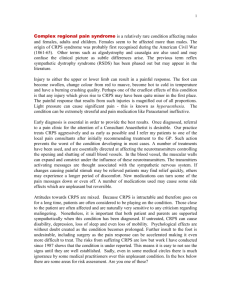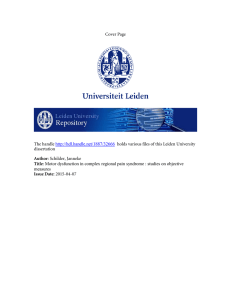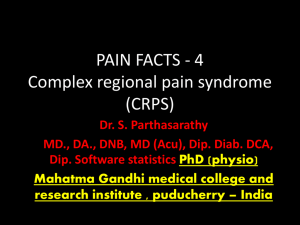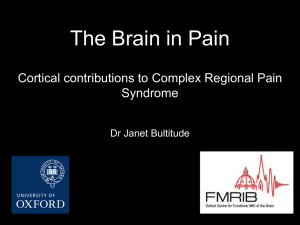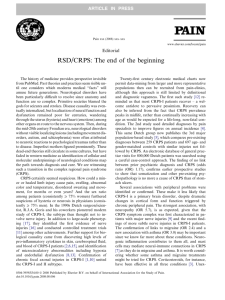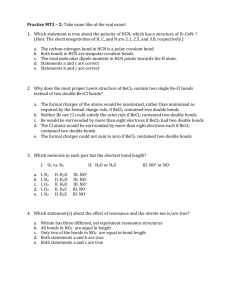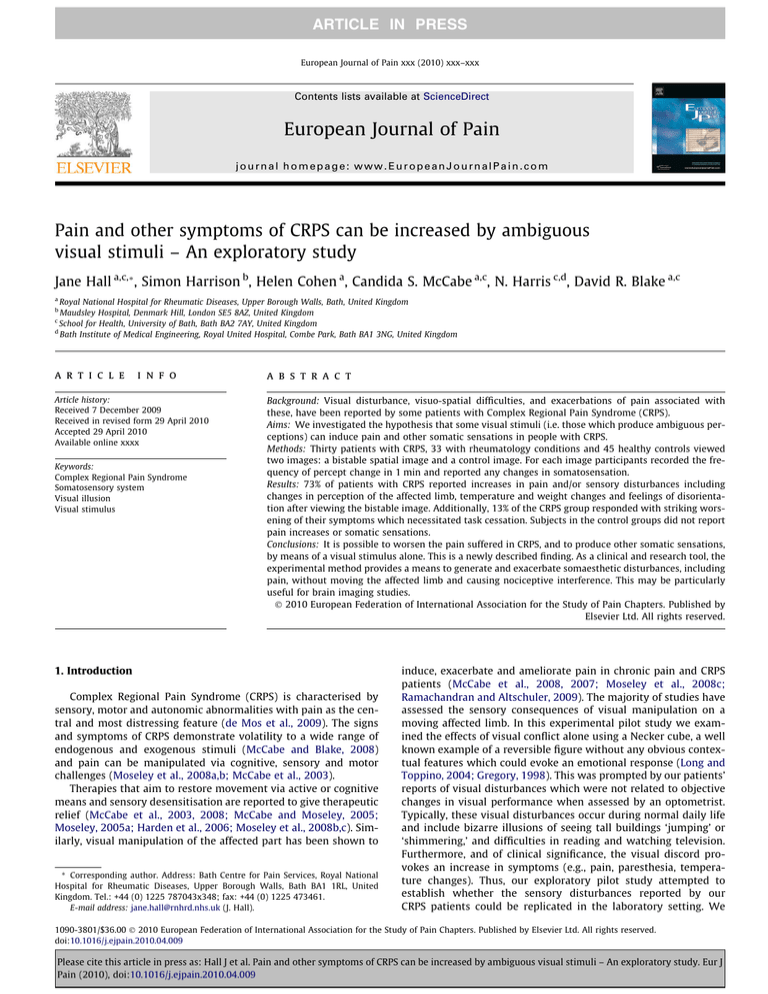
ARTICLE IN PRESS
European Journal of Pain xxx (2010) xxx–xxx
Contents lists available at ScienceDirect
European Journal of Pain
journal homepage: www.EuropeanJournalPain.com
Pain and other symptoms of CRPS can be increased by ambiguous
visual stimuli – An exploratory study
Jane Hall a,c,*, Simon Harrison b, Helen Cohen a, Candida S. McCabe a,c, N. Harris c,d, David R. Blake a,c
a
Royal National Hospital for Rheumatic Diseases, Upper Borough Walls, Bath, United Kingdom
Maudsley Hospital, Denmark Hill, London SE5 8AZ, United Kingdom
c
School for Health, University of Bath, Bath BA2 7AY, United Kingdom
d
Bath Institute of Medical Engineering, Royal United Hospital, Combe Park, Bath BA1 3NG, United Kingdom
b
a r t i c l e
i n f o
Article history:
Received 7 December 2009
Received in revised form 29 April 2010
Accepted 29 April 2010
Available online xxxx
Keywords:
Complex Regional Pain Syndrome
Somatosensory system
Visual illusion
Visual stimulus
a b s t r a c t
Background: Visual disturbance, visuo-spatial difficulties, and exacerbations of pain associated with
these, have been reported by some patients with Complex Regional Pain Syndrome (CRPS).
Aims: We investigated the hypothesis that some visual stimuli (i.e. those which produce ambiguous perceptions) can induce pain and other somatic sensations in people with CRPS.
Methods: Thirty patients with CRPS, 33 with rheumatology conditions and 45 healthy controls viewed
two images: a bistable spatial image and a control image. For each image participants recorded the frequency of percept change in 1 min and reported any changes in somatosensation.
Results: 73% of patients with CRPS reported increases in pain and/or sensory disturbances including
changes in perception of the affected limb, temperature and weight changes and feelings of disorientation after viewing the bistable image. Additionally, 13% of the CRPS group responded with striking worsening of their symptoms which necessitated task cessation. Subjects in the control groups did not report
pain increases or somatic sensations.
Conclusions: It is possible to worsen the pain suffered in CRPS, and to produce other somatic sensations,
by means of a visual stimulus alone. This is a newly described finding. As a clinical and research tool, the
experimental method provides a means to generate and exacerbate somaesthetic disturbances, including
pain, without moving the affected limb and causing nociceptive interference. This may be particularly
useful for brain imaging studies.
Ó 2010 European Federation of International Association for the Study of Pain Chapters. Published by
Elsevier Ltd. All rights reserved.
1. Introduction
Complex Regional Pain Syndrome (CRPS) is characterised by
sensory, motor and autonomic abnormalities with pain as the central and most distressing feature (de Mos et al., 2009). The signs
and symptoms of CRPS demonstrate volatility to a wide range of
endogenous and exogenous stimuli (McCabe and Blake, 2008)
and pain can be manipulated via cognitive, sensory and motor
challenges (Moseley et al., 2008a,b; McCabe et al., 2003).
Therapies that aim to restore movement via active or cognitive
means and sensory desensitisation are reported to give therapeutic
relief (McCabe et al., 2003, 2008; McCabe and Moseley, 2005;
Moseley, 2005a; Harden et al., 2006; Moseley et al., 2008b,c). Similarly, visual manipulation of the affected part has been shown to
* Corresponding author. Address: Bath Centre for Pain Services, Royal National
Hospital for Rheumatic Diseases, Upper Borough Walls, Bath BA1 1RL, United
Kingdom. Tel.: +44 (0) 1225 787043x348; fax: +44 (0) 1225 473461.
E-mail address: jane.hall@rnhrd.nhs.uk (J. Hall).
induce, exacerbate and ameliorate pain in chronic pain and CRPS
patients (McCabe et al., 2008, 2007; Moseley et al., 2008c;
Ramachandran and Altschuler, 2009). The majority of studies have
assessed the sensory consequences of visual manipulation on a
moving affected limb. In this experimental pilot study we examined the effects of visual conflict alone using a Necker cube, a well
known example of a reversible figure without any obvious contextual features which could evoke an emotional response (Long and
Toppino, 2004; Gregory, 1998). This was prompted by our patients’
reports of visual disturbances which were not related to objective
changes in visual performance when assessed by an optometrist.
Typically, these visual disturbances occur during normal daily life
and include bizarre illusions of seeing tall buildings ‘jumping’ or
‘shimmering,’ and difficulties in reading and watching television.
Furthermore, and of clinical significance, the visual discord provokes an increase in symptoms (e.g., pain, paresthesia, temperature changes). Thus, our exploratory pilot study attempted to
establish whether the sensory disturbances reported by our
CRPS patients could be replicated in the laboratory setting. We
1090-3801/$36.00 Ó 2010 European Federation of International Association for the Study of Pain Chapters. Published by Elsevier Ltd. All rights reserved.
doi:10.1016/j.ejpain.2010.04.009
Please cite this article in press as: Hall J et al. Pain and other symptoms of CRPS can be increased by ambiguous visual stimuli – An exploratory study. Eur J
Pain (2010), doi:10.1016/j.ejpain.2010.04.009
ARTICLE IN PRESS
2
J. Hall et al. / European Journal of Pain xxx (2010) xxx–xxx
hypothesised that pain and other symptoms would be exacerbated
when people with CRPS viewed the Necker cube: (i) compared to
viewing an unambiguous, non-reversible figure and (ii) compared
to people with other chronic pain conditions, or healthy controls.
Time
Familiarisation
2. Method
The perception of pain is a complex construct, thus a mixed
methods study was employed to generate deeper insights than
would be possible with a quantitative method alone.
A purposive sample of adult patients who met the IASP diagnostic criteria for CRPS type 1 (Bruehl et al., 1999) were recruited from
patients attending the CRPS service at the Royal National Hospital
for Rheumatic Diseases (RNHRD), Bath. There were two control
groups; patients with general chronic rheumatology conditions recruited from the hospital clinics, and a group of healthy volunteers
recruited from staff and visitors. Participants were excluded if they
had a concurrent neurological diagnosis, loss of vision or visual disturbances (e.g., blurred/double vision) or had viewed the Necker
cube during clinical practice. No limitations were placed on routine
medication prior to testing. The sample size was based on the
number of subjects available within the 6-month time period.
Participants were informed that the purpose of the study was to
explore the effects of visual tasks in chronic pain conditions. The
rationale provided was that people with chronic pain may differ
from healthy controls in processing visual signals due to the attentional demands of pain. Importantly, the participant information
sheet stressed that the focus of the study was quantitative (relating
to the number of times the percept altered) and there was no mention of potential sensory changes. This explanation met the criteria
for informed consent as outlined by the approving ethics committee (Bath Local Ethics committee, UK) but was considered sufficiently vague not to induce a source of bias.
2.1. Procedure
A sequence of three images, each printed on an A4 sized card
were shown: these consisted of an ambiguous Duck/Rabbit image,
a Necker Cube (RF) and a non-reversible figure (NRF) depicting the
inner rectangle and dot from the Necker figure, which represented
the control condition (Fig. 1). The images were placed on a table
and the participants seated in a chair at a distance that approximated reading distance, thus the images subtended approximately
4–10° of the visual arc. This figure is only approximate as the participants were invited to view the images from a comfortable,
rather than precisely determined, read position.
Informed consent was taken, in accordance with the Declaration of Helsinki, 1996 guidance and a short interview to establish
demographic and current health status. The Duck/Rabbit was used
to illustrate the experimental task and was chosen for this purpose
because it lacks the spatial percept inherent in the Necker cube.
The bistable nature of the image was pointed out to the participants, who were then asked to confirm that they could see both
the Duck and the Rabbit by pressing a digital counter, using their
preferred hand. Participants were then informed that they would
be shown a series of pictures and again, asked to indicate changes
in percept. All participants were cued to focus on the frequency of
percept change. Care was taken not to specify the number of pictures to be shown.
The RF and NRF were then shown in sequence, with sequential
alteration between participants, for a maximum of 60 s each. A rest
period of two minutes was given between each of the figures. At
the end of 2 min subjects who did not feel ready to continue were
given up to 10 min before continuing. Before and after each viewing condition patients verbally rated their pain intensity using an
Until 3 button
presses
Rest 2 mins
I minute
Press when see
change
Rest 2-10 min
I minute
Press when see
change
Rest 2-10 min
Fig. 1. Flow diagram illustrating the sequence of images.
eleven point numerical rating pain scale (NRS – where 0 was
equivalent to no pain at all, and 10 to the worst pain imaginable
(Williamson and Hoggart, 2005), and to describe what they saw
and what, if anything different they felt, during the viewing. These
descriptions were recorded verbatim by the researcher.
2.2. Data analysis and management
In order to test the hypothesis that the RF condition would increase pain intensity (Numerical Rating Scale) more than the NRF
in the CRPS group we undertook repeated measures ANOVA with
group as between subjects factor and condition (RF and NRF) and
time (pre and post) as within subjects factors. Given the wide variance in pain intensity between patients and healthy controls and
the assumption of similar variability between groups required by
ANOVA, only the CRPS and rheumatology group data were entered
into this analysis. The number of percept changes was analysed by
one-way ANOVA to examine for group differences; a paired t-test
was used to examine differences between figures.
Qualitative data, generated from the subjects’ responses to the
open questions was tabulated on MS-Excel and analysed using
content analysis (Holsti, 1968; Frankfort-Nachmias and Nachmias,
1992). A process of iterative inductive generation of categories
from the descriptive responses generated a number of themes,
which corresponded to the diagnostic criteria for CRPS vasomotor,
sudomotor and motor symptoms (sensory, pain and paresthesia
were coded separately). Other categories included body perception
disturbances (weight/pressure changes, altered sensitivity, loss of
limb), affective (feelings of frustration, anxiety, tension) and
miscellaneous (disorientation, nausea, eye fatigue, dry mouth). A
Please cite this article in press as: Hall J et al. Pain and other symptoms of CRPS can be increased by ambiguous visual stimuli – An exploratory study. Eur J
Pain (2010), doi:10.1016/j.ejpain.2010.04.009
ARTICLE IN PRESS
3
J. Hall et al. / European Journal of Pain xxx (2010) xxx–xxx
second independent coder verified category generation; the interrater reliability was found to be Kappa = 0.69 (P < 0.001).
For statistical testing, these data were summarised by determining the frequency of report of a particular sensation at each
stage of the protocol and its reported change. The data were analysed in three categories according to reported change (worse,
same, better), and two categories according to type (pain/other somatic sensations).The data were examined using Chi-square test.
All statistical tests were performed using SPPS Version 16, a P value
60.05 was considered significant.
3. Results
Thirty patients with CRPS (Type I), 33 with general rheumatology disease and 45 healthy controls were studied. Table 1 details
the demographics of the participants recruited.
3.1. Statistical analysis
There was main effect on Numerical Pain Rating of group
(F(1, 61 = 7.33, P = 0.009) (Table 2). There were significant ‘‘group
by time” (F(1, 61) = 8.4; P = 0.005) and ‘‘condition by time by
group interactions” (F(1, 61) = 8.67; P = 0.005). This means that
pain intensity differed significantly between condition and group
such that pain increased in the CRPS group and decreased in the
rheumatology group after viewing the RF (Fig 2). There was, similarly, a significant difference between the CRPS and rheumatology
groups, for frequency of qualitative pain (Chi-square: X2 = 19.9,
P < 0.01) and of other bodily sensation change (X2 = 17.5;
P < 0.01) (Table 3). Table 4 defines the type of somaesthetic
changes experienced by each of the groups. In addition 37% of patients with CRPS reported increasing somaesthesia during NRF.
While there was, as expected, a significant difference between
the two visual stimuli in the number of percept changes, there
Table 1
Participant characteristics.
Subject characteristics
CRPS (n = 30)
Rheumatology (n = 33)
Healthy controls (n = 45)
Age (years) [mean& range]
Male
Distribution of CRPS/rheumatology conditions (n=)
42 (20–63)
9
UL = 13
LL = 10
ULLs = 4
LT = 3
63.6 (24–88)
10
RA = 16
OA = 13
V=2
AS = 1
PsA = 1
46 (22–64)
4
Time since diagnosis [median (range)]
Numerical Pain Rating scale (mean&SD)
Frequency of comorbidity
Medication (n)
DMARDs
Non-opioid analgesic
NSAID
Weak opioid analgesic
Strong opioid
Steroid
Osteoporosis prophylaxis treatment
Gastroprotection
Cardiovascular
Anti-epileptic/anti-depressant
Oral hypoglcaemics
Lipid lowering drugs
HRT
Respiratory medication
Miscellaneous
16 months (0–9 years)
6.17 (2)
46.6%
5.1 (2.7)*
59.9%
0.044 (0.2)
28.8%
0
11
9
17
7
0
2
3
6
18
0
0
4
5
12
15
12
13
16
5
9
13
16
22
8
5
7
2
1
10
0
1
2
0
0
2
0
1
4
3
1
3
3
3
3
UL – upper limb, LL – lower lib, ULLs – upper and lower limbs, LT – limb and trunk.
RA – rheumatoid arthritis, OA – osteoarthritis, V – vasculitis, AS – ankylosing spondylitis, PSa – psoriatic arthritis.
DMARDs – disease modifying anti-rheumatic drugs.
NSAID – non steroidal anti-inflammatory drug.
Cardiovascular (Inc. antihypertensives, antiarhythmics, anti-anginal drugs, anti-platelet agents, anticoagulants).
HRT – hormone replacement (Inc. thyroxine).
Miscellaneous (vitamin/iron supplementation, antihistamine, night sedation, prostate/bladder medications, antibiotics, antiemetics, quinine).
*
There were no significant differences in pain at baseline between patients in the CRPS and rheumatology groups (unpaired t-test).
Table 2
Results from repeated measures ANOVA on Numerical Pain Rating Scale (n = 63).
Source of variation
df
Sum of squares
Mean square
F
P
Group
Error
Condition
Error
Time
Error
Group condition
Group time
Condition time
Group condition time
1
61
1
61
1
61
1
1
1
1
179.5
1492.8
0.005
31.1
0.174
23.6
0.017
3.26
0.075
3.15
179.5
24.5
0.005
0.509
0.174
0.39
0.017
3.26
0.075
3.15
7.33
–
0.009
–
0.45
–
0.033
8.4
0.206
8.67
0.009
–
0.9
–
0.5
–
0.86
0.005
0.65
0.005
Please cite this article in press as: Hall J et al. Pain and other symptoms of CRPS can be increased by ambiguous visual stimuli – An exploratory study. Eur J
Pain (2010), doi:10.1016/j.ejpain.2010.04.009
ARTICLE IN PRESS
4
J. Hall et al. / European Journal of Pain xxx (2010) xxx–xxx
Fig. 2. Pain intensity on a 10 cm numerical rating scale (mean and SD) before and after each figure.
Table 3
Number and (%) of participants reporting altered pain and somaesthesia during reversible (RF) and non-reversible figure (NRF) viewing. Pain increased in the CRPS group and
decreased in the rheumatology group during RF (P < 0.01). A significantly greater proportion of the CRPS group reported somaesthetic disturbance during RF and NRF (P < 0.01).
Qualitative pain
Increased
Same
Decreased
RF
NRF
CRPS (n = 30)
Rheumatology (n = 33)
Control (n = 45)
CRPS (n = 30)
Rheumatology (n = 33)
Control (n = 45)
13 (43%)
16 (53%)
1 (3%)
2 (6%)
18 (54.5%)
13 (39.4%)
0 (0)
44 (97.8)
1 (2.2)
3 (10%)
24 (80%)
3 (10%)
2 (6%)
27 (81.8%)
4 (12%)
0
100 (100%)
0
5 (15%)
28 (85%)
0
3 (7%)
42 (93%)
0
11 (37%)
14 (47%)
5 (17%)
2 (6%)
31 (94%)
0
3 (7%)
42 (93%)
0
Qualitative: somaesthesia
Increased
15 (50%)
Same
12 (40%)
Decreased
3 (10%)
Table 4
Number of participants (%) reporting presence, exaggeration or amelioration of somaesthetic experiences, excluding sensory pain, in each of the coding categories.
Exacerbation of symptoms
CRPS
Sensory-paresthesia
Vasomotor
Sudomotor
Motor
Body Perception change
Affective
Miscellaneous
Amelioration of symptoms
Rheum
HC
CRPS
Rheum
HC
RF
NRF
RF
NRF
RF
NRF
RF
NRF
RF
NRF
RF
NRF
7
8
4
3
6
5
9
2
2
1
2
2
2
7
–
–
–
–
–
2 (6.7)
3 (10)
–
–
–
–
–
–
–
–
–
–
–
–
–
3 (9)
–
–
–
–
–
–
3 (9)
1
1
–
–
2
1
–
2 (4.4)
–
–
–
2 (4.4)
–
–
–
–
–
–
–
–
–
–
–
–
–
–
–
–
–
–
–
–
–
–
–
–
–
–
–
–
–
–
(23.3)
(26.6)
(13.3)
(10)
(20)
(16.6)
(30)
(6.7)
(6.7)
(3.3)
(6.7)
(6.7)
(6.7)
(23.3)
(2.2)
(2.2)
(4.4)
(2.2)
Sensory-paresthesia changes: pins and needles, formication.
Vasomotor changes: temperature or colour changes.
Sudomotor changes: sweating changes.
Motor changes: changes in or presence of cramping, stiffness, twitching, tremor.
Body perception changes: weight/pressure changes, altered sensitivity, loss of limb.
Affective symptoms: feelings of frustration, anxiety, tension and well being.
Miscellaneous symptoms: disorientation, nausea, fatigue, eye fatigue and dry mouth.
was no difference between groups (Table 5). However, of interest is
that four participants in the CRPS group found the RF changed
more frequently than the button could be pressed and were unable
to complete the task for the full minute.
3.2. Qualitative results
Participants in the rheumatology and healthy control groups reported fewer and more minor sensory disturbances when viewing
the figures compared to the CRPS group (Table 4). Most of these
sensory effects related to eye fatigue and feelings of slight disorientation (‘‘almost felt a bit wobbly”, and ‘‘I felt agitated/squiffy”).
Table 5
Frequency of button press (mean and SD). Excludes data from four subjects in CRPS
group as speed of percept change was too rapid to record and subjects were unable to
view for full duration.
Reversible figure
Non-reversible figure
CRPS (n = 26)
Rheum (n = 33)
HC (n = 45)
9.7 (6.5)
1.2 (2.3)
7.7 (5.1)
0.7 (1.5)
8.9 (4.6)
0.7 (1.5)
Please cite this article in press as: Hall J et al. Pain and other symptoms of CRPS can be increased by ambiguous visual stimuli – An exploratory study. Eur J
Pain (2010), doi:10.1016/j.ejpain.2010.04.009
ARTICLE IN PRESS
J. Hall et al. / European Journal of Pain xxx (2010) xxx–xxx
When viewing the RF and NRF respectively, some participants (12
for RF, 2 for NRF) in the rheumatology group described that their
pain diminished and attributed this to ‘‘my mind is concentrating
on something other than pain”.
In the CRPS group eight subjects responded in a similar way to
the healthy volunteers in that six reported no change in any sensations to either figure. Of the remaining two subjects, one reported
amelioration of their symptoms – attributed to distraction via
attention to the figures – and one noted that they felt ‘‘a little bit
giddy, probably because I was staring at it”. The remaining 22 subjects (73%) responded in ways that were different from the healthy
and rheumatology groups. These responses ranged from the mildly
to the extremely distressing. Responses at the mild end of the spectrum were isolated or temporary sensations. For example, one subject reported that their pain became more ‘nagging’; another
reported the onset of ‘tingling’ on their (affected) forearm, which
ceased when the stimulus was removed.
Four subjects with CRPS reported being extremely distressed and
were unable to look at the RF for the full minute (mean: 40 s, SD:
15.7) due to increases in pain. Furthermore, two of these patients
were unable to view the NRF for the full minute (14 s and 28 s).
The symptoms reported included paresthesia (‘‘the tingling has
changed to a very deep and irritating feeling”), dizziness, nausea
(‘‘don’t feel too good. . . . . .sweaty, feel flushed, sickly, hot, bothered”), temperature changes (‘‘foot is flushed hot now”), perceived
weight changes (‘‘right shoulder feels heavy”, ‘‘entire arm heavy”)
and disorientation (‘‘feel almost trance-like”). Observation of these
subjects showed a characteristic pattern of extreme blinking, looking away, and finally shutting their eyes with head averted and asking for the picture to be removed. No differences between these four
subjects and others in the CRPS group could be found in relation to
baseline pain (NRS), location, symptom duration or medication.
All sensory changes reported by the rheumatology and healthy
control groups disappeared rapidly on removal of the stimulus.
Whilst this was similar for most of the CRPS group, four of the participants had not returned to their baseline pain values by the end
of the 2 min rest period and all required the maximum recovery
time before proceeding to the next stage of the protocol.
4. Discussion
The data supports the hypothesis that pain and other symptoms
are exacerbated in patients with CRPS, when viewing the RF compared to viewing the NRF but not in other chronic pain patients or
healthy controls. Both qualitative and quantitative data supported
the hypothesis but the qualitative data was particularly strong
with 73% of the CRPS group reporting exacerbation of their pain
or other CRPS symptoms on viewing the RF. Furthermore, we identified a small group (13%) who responded with striking worsening
of their symptoms, and consequent inability to complete the
experimental task. These results differ significantly from rheumatology patients and healthy controls who reported only minor
symptoms; in the former group almost half reported improvement
in their pain due to attending to the picture. The experimental design does not allow us to attribute the results to the RF alone but it
would appear that symptom increase is confined to patients with
CRPS.
Our study is limited by the lack of quantitative measures as
well as several possible confounding factors. Expectation, suggestion and arousal are possible sources of confounding. The investigators were not blind to the study’s hypotheses; however, every
attempt was made to use neutral language and to draw subjects’
attention to the button count rather than their experiences. Medication may have had an effect on our outcomes as all of the ‘severe’ responders were on anticonvulsant medication. However,
5
half of the CRPS sample group with mild response were also on
similar dosages of psychotropic medication. Furthermore, 24% of
the rheumatology group were taking antidepressants also and
none of these patients exhibited more than minor symptoms.
Nevertheless future studies should include medication and dose
as covariates.
Participants with CRPS demonstrated a spectrum of response
ranging from none to severe distress which in some cases necessitated task cessation. These participants reported reversal rates
which were too fast to record, suggesting that the speed of reversal
was linked to symptom exacerbation. This might be further tested
by using two images that are highlighted to draw attention to only
one of the two potential visual precepts and these images being
alternated in a graded, accelerating manner whilst the subjects’
symptom responses are recorded (e.g. a single session of fixed time
with the rate of image change controlled at a fixed speed. Escalation of speed of image change in subsequent sessions would allow
systematic responses to be measured). Objective evidence of autonomic changes within the affected limb could be captured in this
paradigm by adding measures of galvanic skin response and laser
Doppler flowmetry.
The switching rate of RF has been used to elucidate the processes underlying perceptual instability and using fMRI, Lumer et
al. (1998) showed that activity in the visual and frontoparietal
cortices was heightened during perceptual transitions (Sterzer
et al., 2002; Long and Toppino, 2004). It is of note that superior
and inferior parietal lobes and anterior intraparietal sulcus are
involved in switching as these areas are also activated during
hand laterality tasks. The response to such tasks is slower for
the affected side in CRPS and suggests disruption of the body
schema, the neural correlates of which reside in the parietal cortices (de Lange et al., 2006; Moseley, 2004). Our clinical experience has shown that some patients respond to laterality training
in a similar manner to a RF and therefore using a bistable image
might provide a rapid clinical assessment to establish suitability
for hand laterality training. That perceptual transitions activate
the parietal cortices is of particular interest in CRPS aetiology,
firstly because of its afferent role in movement via sensory integration and secondly, because it maps for the body schema, disruption of which is reported in CRPS (Lewis et al., 2007;
Moseley, 2005b; Förderreuther et al., 2004; Galer and Jensen,
1999). Future studies in which the relationships between the response to perceptual instability, Body Perception Disturbance
and vulnerability to sensorimotor disruption are examined may
add to the body of literature suggestive of parietal dysfunction
in CRPS (Cohen et al., 2009; Schwenkreis et al., 2009; Schwoebel
et al., 2001).
5. Conclusion
This exploratory mixed methods study has shown that the
symptoms of CRPS can be exacerbated by viewing ambiguous figures. This phenomenon corroborates anecdotal accounts of the visual disturbances reported by some patients with CRPS. However,
further studies which include objective markers of symptom
change are required to confirm these initial findings. Our experimental method provides a means to generate or exacerbate somaesthetic disturbances, including pain, without nociceptive
interference which could be a useful technique for future studies,
particularly those involving imaging.
Acknowledgements
The authors gratefully acknowledge the support of our research
participants and the Gwen Bush Foundation who funded this
Please cite this article in press as: Hall J et al. Pain and other symptoms of CRPS can be increased by ambiguous visual stimuli – An exploratory study. Eur J
Pain (2010), doi:10.1016/j.ejpain.2010.04.009
ARTICLE IN PRESS
6
J. Hall et al. / European Journal of Pain xxx (2010) xxx–xxx
research. Particular thanks too to Professors Richard Gregory, Ian
Gilchrist and Drs. Peter Tucker and Trevor Day for their helpful
comments when writing this paper.
References
Bruehl S, Harden RN, Galer BS, Saltz S, Bertram M, Backonja M, et al. External
validation of IASP diagnostic criteria for Complex Regional Pain Syndrome and
proposed research diagnostic criteria. International Association for the Study of
Pain. Pain 1999;81:147–54.
Cohen H, McCabe CS, Harris N, Blake DR. Clinical evidence of parietal lobe
dysfunction in patients with CRPS Type 1. Rheumatology 2009;48(S1):i95.
de Lange FP, Helmich RC, Toni I. Posture influences motor imagery: an fMRI study.
NeuroImage 2006;33(2):609–17.
de Mos M, Sturkenboom MC, Huygen FJ. Current understandings on complex
regional pain syndrome. Pain Pract 2009;9(2):86–99.
Declaration of Helsinki (1964). Br Med J 1996; 313:1448–9.
Förderreuther S, Sailer U, Straube A. Impaired self-perception of the hand in
complex regional pain syndrome (CRPS). Pain 2004;110(3):756–61.
Frankfort-Nachmias C, Nachmias D. Research methods in the social sciences. 4th
ed. London: Edward Arnold; 1992.
Galer BS, Jensen M. Neglect-like symptoms in complex regional pain syndrome:
results of a self-administered survey. J Pain Symptom Manage 1999;18(3):
213–7.
Gregory RL. Eye and brain. The psychology of seeing. 5th ed. Oxford: Oxford
University Press; 1998. p. 205.
Harden RN, Swan M, King A, Costa B, Barthel J. Treatment of complex regional pain
syndrome: functional restoration. Clin J Pain 2006;22(5):420–4.
Holsti OR. Content analysis. In: Lindzey G, Aronson E, editors. The handbook of
social psychology. Reading (MA): Addison-Wesley; 1968.
Lewis JS, Kersten P, McCabe CS, McPherson KM, Blake DR. Body perception
disturbance. A contribution to pain in complex regional pain syndrome (CRPS).
Pain 2007;133(1–3):111–9.
Long GM, Toppino TC. Enduring interest in perceptual ambiguity: alternating views
of reversible figures. Psychol Bull 2004;130(5):748–68.
Lumer ED, Friston KJ, Rees G. Neural correlates of perceptual rivalry in the human
brain. Science 1998;280(5371):1930–4.
McCabe CS, Blake DR. An embarrassment of pain perceptions? Towards an
understanding of and explanation for the clinical presentation of CRPS type 1.
Rheumatology (Oxford) 2008;47(11):1612–6.
McCabe C, Moseley L. Functional strategies of restoration of complex regional pain
syndrome. In: Justins D, editor. PAIN 2005 – an updated review: refresher
course syllabus. Seattle: IASP Press; 2005. p. 317–28.
McCabe CS, Haigh RC, Ring EF, Halligan PW, Wall PD, Blake DR. A controlled
pilot study of the utility of mirror visual feedback in the treatment of
complex regional pain syndrome (type 1). Rheumatology (Oxford) 2003;
42(1):97–101.
McCabe CS, Cohen H, Blake DR. Somaesthetic disturbances in fibromyalgia are
exaggerated by sensory motor conflict: implications for chronicity of the
disease? Rheumatology (Oxford) 2007;46(10):1587–92.
McCabe CS, Haigh RC, Blake DR. Mirror visual feedback for the treatment of
complex regional pain syndrome (type 1). Curr Pain Headache Rep 2008;12(2):
103–7.
Moseley GL. Why do people with complex regional pain syndrome take longer to
recognize their affected hand? Neurology 2004;62(12):2182–6.
Moseley GL. Is successful rehabilitation of complex regional pain syndrome due to
sustained attention to the affected limb? A randomised clinical trial. Pain
2005a;114(1–2):54–61.
Moseley L. Distorted body image in complex regional pain syndrome. Neurology
2005b;65:773.
Moseley GL, Zalucki N, Birklein F, Marinus J, van Hilten JJ, Luomajoki H. Thinking
about movement hurts: the effect of motor imagery on pain and swelling in
people with chronic arm pain. Arthritis Rheum 2008a;59(5):623–31.
Moseley GL, Zalucki NM, Wiech K. Tactile discrimination, but not tactile stimulation
alone, reduces chronic limb pain. Pain 2008b;137(3):600–8.
Moseley GL, Parsons TJ, Spence C. Visual distortion of a limb modulates the pain and
swelling evoked by movement. Curr Biol 2008c;18(22):R1047–8.
Ramachandran VS, Altschuler EL. The use of visual feedback, in particular
mirror visual feedback, in restoring brain function. Brain 2009;132(Pt 7):
1693–710.
Schwenkreis P, Maier C, Tegenthoff M. Functional imaging of central nervous
system involvement in complex regional pain syndrome. AJNR Am J
Neuroradiol 2009;30(7):1279–84.
Schwoebel J, Friedman R, Duda N, Coslett H. Pain and the body schema. Evidence for
peripheral effects on mental representations of movement. Brain 2001;124:
2098–104.
Sterzer P, Russ MO, Preibisch C, Kleinschmidt A. Neural correlates of spontaneous
direction reversals in ambiguous apparent visual motion. NeuroImage
2002;15(4):908–16.
Williamson A, Hoggart B. Pain: a review of three commonly used pain rating scales.
J Clin Nurs 2005;14(7):798–804.
Please cite this article in press as: Hall J et al. Pain and other symptoms of CRPS can be increased by ambiguous visual stimuli – An exploratory study. Eur J
Pain (2010), doi:10.1016/j.ejpain.2010.04.009

